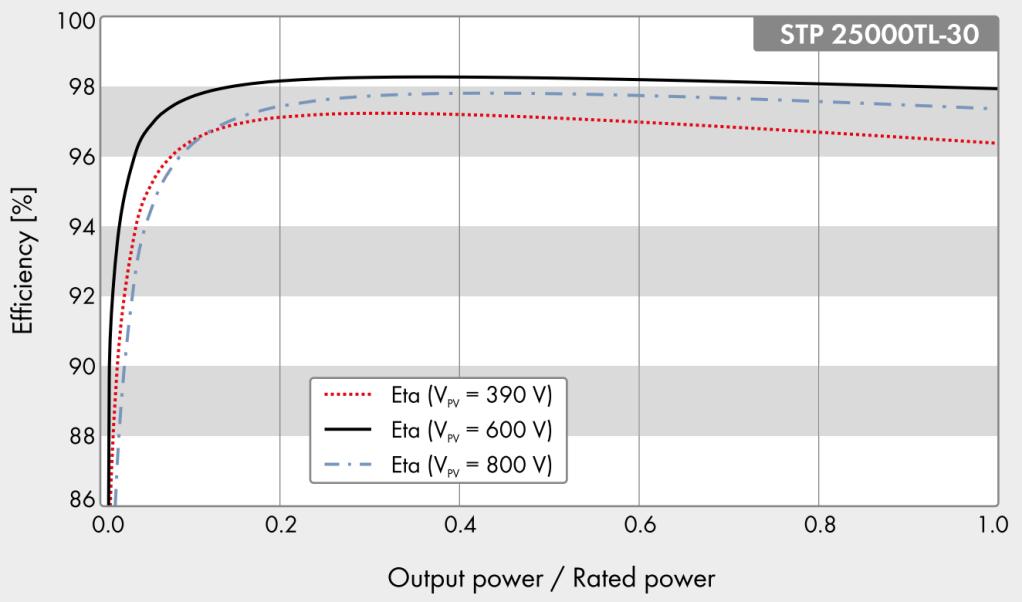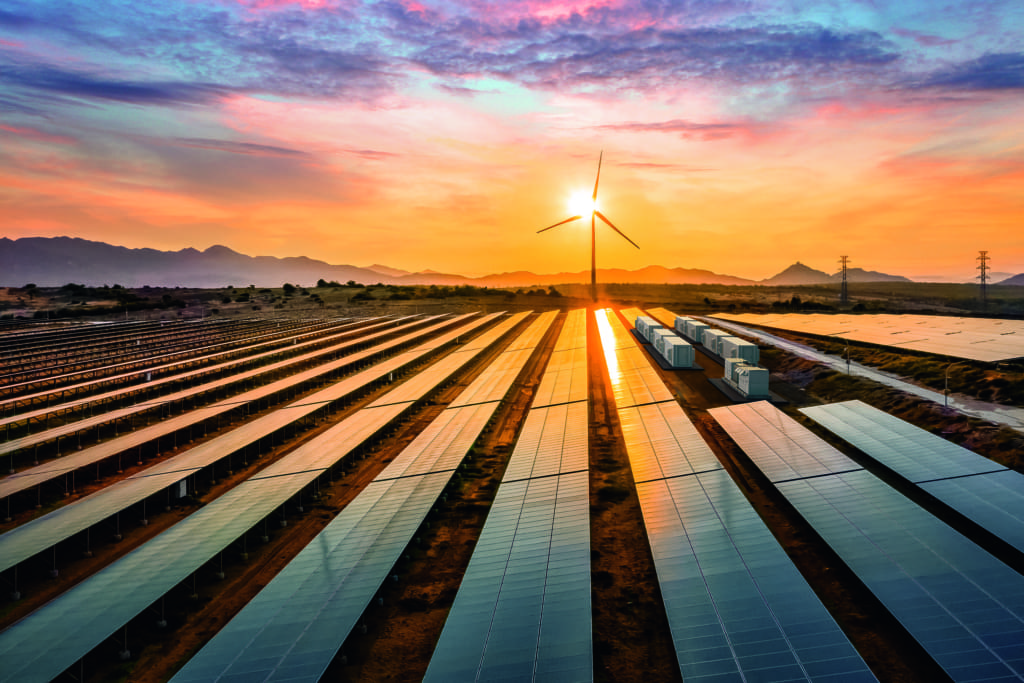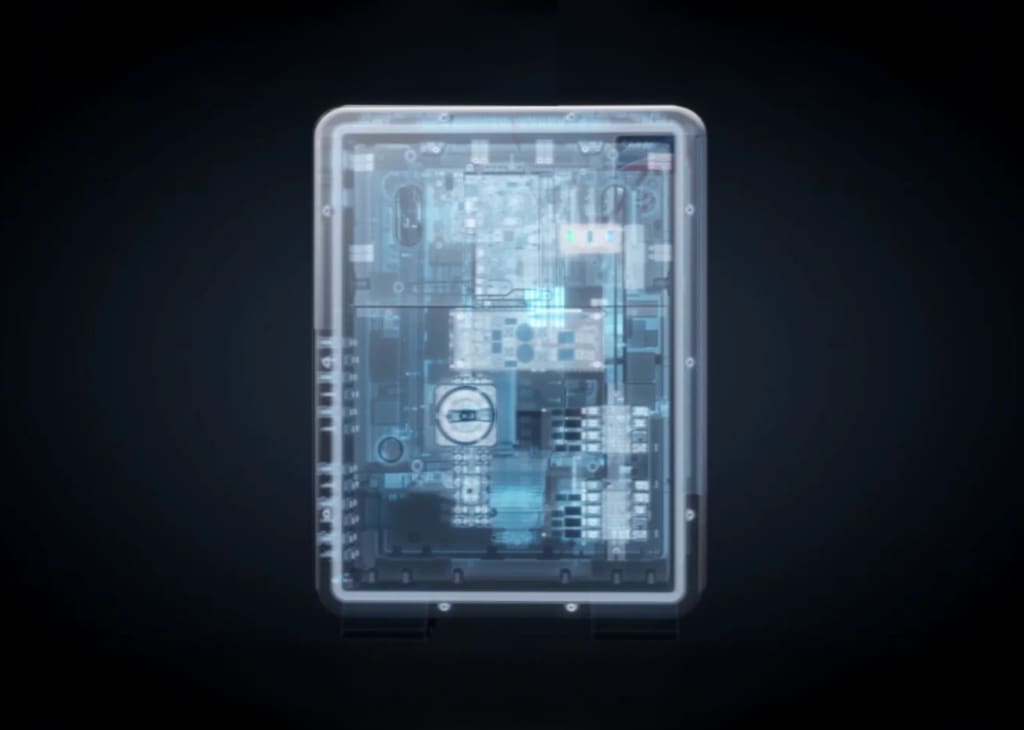7 Reasons Why You Should Oversize Your PV Array

Oversizing a PV array, also referred to as undersizing a PV inverter, involves installing a PV array with a rated DC power (measured @ Standard Test Conditions) which is larger than an inverter’s rated AC output power (i.e. DC @ STC > AC). It can be a valuable tool for system designers seeking to deliver a maximum amount of energy at a lowest possible specific cost. Reasons for over-sizing PV arrays and important factors to consider are summarized below.
1. Make better use of the inverter’s AC output
PV modules have ratings which define how they will operate. Their power, current and voltage ratings are all defined at Standard Test Conditions (STC). STC is defined as operating at:
- 25º Celsius
- Air Mass 1.5
- Insolation 1000W/m2
However, it’s obvious that a PV module would rarely be subjected to these conditions under real world operating scenarios. Operating conditions can vary throughout the day and temperature can greatly impact the output power of a PV array. As the temperature of a PV array increases, its voltage and power will decrease. Typically at solar noon (maximum solar irradiation), a PV array will have its STC output power de-rated by between 20-25 percent due to the array operating above 25ºC. That would mean that at solar noon on a clear sunny day a 100kW PV array would probably be generating approximately 77kW. That’s 23 percent of the array’s rated power not being delivered!
If a PV array will never deliver its rated power, sizing an inverter to match that array’s typical peak power can make better use of the inverter’s AC output capacity.
2. Lower the specific cost of energy delivered
By oversizing a PV array, a lower cost of delivered energy can be realized (lower $/kWh). Oversizing a PV array will increase the cost of PV modules and array racking for a system. However, since this can be achieved without necessarily increasing either the quantity of rating of other balance of system components, the increased energy production is achieved with a lower $/kW installed cost. This in turn yields in a lower specific cost of energy delivered by the system. An example comparison made using Sunny Design shows that by oversizing a PV array with a 5kW inverter, the annual energy yield of a system can be increased by over 28 percent for only a roughly 10 percent increase in the total cost of installation.
3. Reduce inverter costs
By oversizing a PV array, the DC energy output of that array can better match the rated AC power of an inverter. This means that an inverter with a lower AC rating (and thus lower cost) can be used. Consequently, this can decrease the relative cost of inverters compared to the total system cost.
4. Achieve favorable energy output when installing inverters in limited space
Inverters sometimes need to be installed in specific locations, either due to constraints from the owner or local electrical regulations. This may mean it would not be possible to install as many inverters at a site as would be desired for a perfectly sized system. However by oversizing PV arrays, it may be possible to achieve almost the same annual energy output with fewer installed inverters. For example, using Sunny Design, a 100kW PV array with three Sunny Tripower 25000TL inverters (i.e. 75kW of inverters) would produce roughly 2 percent less annual energy compared to the same PV array with four Sunny Tripower 25000TL inverters (i.e. 100kW of inverters). This means that there is only a near 2 percent lower energy output for 25 percent fewer inverters.
5. Maximize the value of daytime energy to the system owner
For a business which operates during normal business hours, the value of daytime energy from their PV system might be different depending on individual circumstances. The PV output may be used to avoid peak-capacity grid charges or to offset constant loads which may be operating on the site. In such cases, oversizing a PV array could provide a business with greater certainty in their energy costs, especially given the low price of PV modules in today’s market. By oversizing a PV array, the inverter can reach its rated AC capacity earlier in the day, and continue operating at that point until late in the afternoon as shown in the following graph.
6. Better match the inverter to the PV array, in the event an inverter needs to be replaced
Sometimes if an inverter fails once it has exceeded its warranty period and it is not always possible to replace it with the same model inverter. In such cases an inverter of a different AC output power may need to be purchased and installed. By installing an inverter with a lower AC output power, the existing PV array could be better matched to the inverter’s capacity and the replacement cost to the system owner minimized.
7. Make the most of East-West PV arrays
Often, PV arrays are installed to maximize energy output and as so are tilted towards the equator (south facing in the northern hemisphere, north facing in the southern hemisphere). Sometimes however the array plane available for installing PV modules with these ideal orientation conditions may not be as great as other less ideal array planes. In cases where the area available for east and west facing orientations is greater, a PV array might be split into some east facing strings and some west facing strings. Since an east and west PV array will peak in output power at different times of the day, it is possible to greatly oversize a PV array (e.g. install a DC input power equal to the inverter AC output power for EACH of the east and west PV arrays). Using an inverter’s sizing capability in such a way can deliver greater overall energy output, and a more level AC output each day.
FACTORS TO CONSIDER WHEN OVERSIZING
There are two important factors which must be considered when designing for and installing oversized PV arrays:
1. Inverter input conditions
The most important input characteristic which should NEVER be exceeded for any SMA inverter is the input voltage limit. Inverters and their constituent components are designed and rated for certain input voltage levels. If an input voltage were to exceed this rating, it will almost certainly result in the inverter’s immediate failure. When oversizing a PV array, it is important to never exceed an inverter’s maximum input voltage. Consideration should also be given to the maximum power point tracker’s operating voltage range, to make sure that the PV array will not go outside that range. When a PV array voltage is outside an MPPT voltage range, the inverter is not able to maximize the performance of the system.
To most easily design an oversized PV array, Sunny Design is the simplest tool since it can provide warnings if a design will exceed an inverter’s critical input parameters.2. Inverter Operating Efficiency and Heat Generation
Broadly speaking, the efficiency loss from an inverter is realized as heat generation. An inverter has a different operating efficiency at different output powers. The example curve below shows that for an Sunny Tripowrer 25000TL, at certain input voltage levels, operation is between 0.5-1.0 percent less efficient at full rated output power compared to 60 or 80 percent rated output power. This could result in more than double the heat generation at 100 percent AC output power compared to 60 or 80 percent AC output power. And when oversizing a PV array an inverter will be more often operate at or close to its rated AC output power, heat generation from the inverter may create an issue for the installation location especially if inverters are installed in a plant room or similar where air flow and heat dissipation might be limited.
Summary
There can be many different reasons to install an oversized PV array. Given PV array’s rarely operate at their rated peak power, oversizing a PV array can make better use of an inverter’s rated AC output and deliver a lower cost/watt system resulting in a lower specific cost of energy delivered ($/kWh). When oversizing PV arrays it is important that an inverter’s critical input limits are never exceeded. Sunny Design is the perfect tool to use when attempting to design a PV system with an oversized PV array. It is important to always comply with local electrical regulations and to use appropriately qualified system designers and installers.







Dear Sir,
We have to design 40kWp solar module bank to SMA 25000TL.Is it applicable or good for our design,Please inform us for our query.
Harikrishnan – According to the datasheet (https://files.sma.de/downloads/STP15-25TL-30-DS-en-40.pdf) a 40kW STC rated array would be allowed, as long as you ensure the DC voltage limit of 1000VDC and short circuit current limit (43A per input) are never violated. However, I would recommend entering your design into Sunny Design Web (https://www.sunnydesignweb.com/) to simulate your specific layout to see what the program determines clipping losses would be if any.
Ordered a SMA Sunny Boy GTI 5kw-5000 US-41…should be here in a week.
3 DC circuits…so I believe I can wire 2 strings in series (A & B, leave C vacant).
I will have 20 Jinko 320watt panels with a 46.4 VOC… (VMP is 37.4 volts)
So, my question is 10×46.40 volts for 464 volts per string. Way under the 600 volt max even for allowing hot temps in the summer and clear cold days in the winter….
Here in Calif we had a few days at 105-107 F…Winter as low as 27 degrees F which makes me worry about temp extremes summer and winter…have not done the calcs yet for winter
Hi Mike
All datasheets from SMA has one number for Maximum input voltage.
This is confusing since almost all inverters have two mppt built in.
For model SMA Tripower 3.0 3000w it says 850V.
Does this mean that I can have 600V connected in PV array A and 450V connected in PV Array B at the same time.
MPPT A and MPPT B are now used in the inverter.
450+600=1050V
Or is the Maximum input voltage of 850V per MPPT even if both are used at the same time ?
If so than both 450V and 650V are ok and well below 850V.
This can be more clear in the datasheets ?
Kim 2
Dear Mike,
We added four Sunny Boy 3.8kwUS inverters to our array. Full sun at 1:00pm gives us individual P: read outs of about 1800w per inverter. Which is about half their maximum. Is that ok, or are we underperforming? The whole system is eighteen inverters, and we are capable of streaming about 90kw on a sunny day at noon. (240 panels up there, but they are ten years old). Can you advise if the new inverters are doing ok? Thanks. Kim
Dear sir,
I want to buy SunnyBoy 6, which is has the following specs:
Maximum PV array power: 9000 Wp
Maximum input voltage: 600 V
MPP voltage range: 25 V to 500 V
Rated input voltage: 365V
I am confused by above numbers. I am planning 2 strings of PV panels, one for each MPPT input. So if I connect my panels in series for a single string and with Vpm adding up, the max number should be 600V, or 500V or 365V per string?
Thanks a lot!
The logbook on sunny portal stop , how do I get it going again.
We have considered Core1 (41 pcs) for the design of a 2.7MWp hybrid solar farm. The ratio per inverter would be 65.8kW(DC)/50kW(AC) or 1.316 – I’m so glad to read this article knowing what we did is right.
SMA is the best!
I’m currently running 20 – 295 watts panel through 1 HPPT port on a Sunny Boy 6.0 inverter. I have 6 – 295 watt panels that were damaged in shipping that I was thinking of adding to the array and using a second HPPT port for them. Two questions: 1) Is using MLSolar epoxy the best way to repair the panels. 2) Is having 20 panels in one port and only 6 in a second port an issue? Thanks for any assistance.
hello,
I have a project in which I have to run a three phase motor of 15 HP. Could you please guide me how to size the system with STP 25000TL-30. How much do I need to oversize the system if I had to run a similar load of 15KW or 20KW with STP 25000TL-30? Also, Could you tell me how to register on the sunny portal for WEB Connect Installed and I couldn’t find any details for how to set the country data set for Pakistan. Lastly, can you also guide me regarding the use of a cluster controller if 3 STP 25000TL-30 are to be used on a project and can you change the number of strings joined in parallel to each input while keeping the same number of modules in each string?
IF I have PV array of 15 KWP and inverter of of 12.5 KW , will it produce the same power as a inverter of 15 KW with same PV array
Hai i am having a project were i need to install a 60kW SMA and the panel capacity is 78kW. Is that ok to oversize 60kW SMA with 78kW panel.
Thank you
Anwar
If I want to oversize the PV array on a 12KW SMA, what would be a same limit to oversize by? 14KW?
I have 15.6KW Installed syatem with SMA 15KW, while the usuall DC high power produce is about 13-13.5KV (pick of ~15.2KW three times a year ). In spite of the efficiancy of the panels (65 units of 240W) increase every year the AC output reduce every year ( I see according the electricity company ).
I live in Israel where the radiation and the tempeture during 6 months are relatively high so the whole system efficiancy reduce.
what is your sugestion to me to increase the AC output?
Hey Scott, It was a complete are satisfactory answer to the question that I was searching for. But, there is one new question that is troubling me now is that what will be the status of peak of peak power. If we have an inverter SMA STP 25000TL and have safely oversized the PV array, lets assume to 30 kWpeak. What will be status of peak output power of the inverter. Will the portal show a value of 25 kW more often or will it never hit the 25kW peak mark?
I have 3640 watts in solar panel
What inversor i Neem
Thank
I side question, which you may have answered before:
After reading the above article it follows to ask a few battery questions. I have a SB3000TL-US-22 and a SI 6048. I have narrowed the batteries down to the NiFe batteries. Are these batteries compatible with the mentioned SI & SB? Are there and special things I would need to do? i.e. modify settings on SI, add additional equipment?
I am a firm believer that the inverter should Not be the limit of the system.
The graph does not show the energy wasted as the production would have peaked at say 13KW or 14KW.
All of the kWh from where the kW line meets 9kW at 08:00 to where is leaves 9kW at 15:30 was lost to time.
You could have just as easily installed 15kW of inverter and gained the following.
I used your graph and added a typical solar inclination curve to the top with the following assumed peak power production.
9kW cap, 92kWh, Base line from your chart
12kW peak, 107kWh, 16% energy increase
13kW peak, 112kWh, 22% energy increase
14kW peak, 116kWh, 26% energy increase
Wasting 16% to 26% system output is hard to justify. Buy the bigger inverter and maximize your production.
If you only want 92kWh daily it would be cheaper to buy a smaller array and a larger inverter.
Inverters are cheap compared to Space and installed panels.
My Opinion…
Ian
Note that the array only operates at this peak output for a handful of days each year, so you are only shaving the peak off the graph for a tiny fraction of your total annual harvest. Not to mention temperature de-rating of the array in summer. What you lose off the top of the curve will not justify the cost differential of the larger inverter. And in some jurisdictions, your grid connection is approved based on inverter size… so you oversize the array to build-up the yield on either side of the graph. Point is, match the operational output of the array to the inverter, not the theoretical.
Graham – I agree with all of your reasoning. SMA’s Sunny Design Web will allow designers to adjust the array size and provide the calculated additional kWhs produced annually so an accurate economic analysis can be done. Also, the “Energy Usability Factor” metric will also alert you when the array is large enough to introduce clipping. The program takes into account the rating of the modules but also the install location, orientation, tilt, irradiance and temperature.